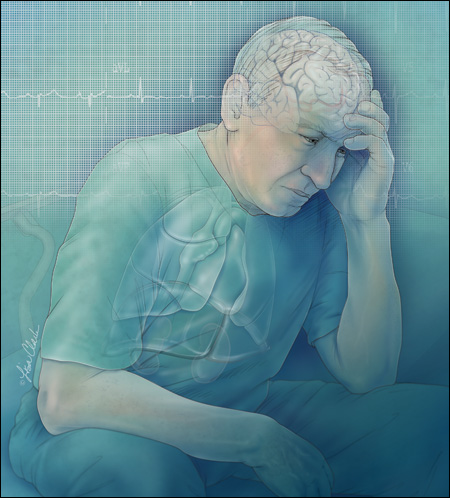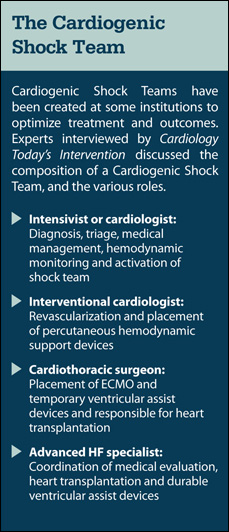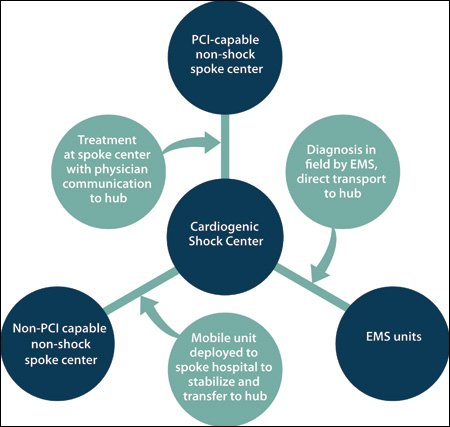Complexities of Cardiogenic Shock
Patients presenting with cardiogenic shock have poor prognosis, but new information may improve outcomes.
The patient with acute MI and cardiogenic shock has long presented physicians with a puzzle in dire need of solving. However, the complex and urgent nature of shock, as well as a lack of data, have left them without an ideal solution.
Cardiogenic shock, which complicates about 5% to 10% of acute MI cases, is associated with a 40% to 50% mortality rate if angioplasty is performed. Unfortunately, this number has remained the same for the past 3 decades, according to William W. O’Neill, MD, medical director for the Center of Structural Heart Disease at Henry Ford Hospital and a member of Cardiology Today’s Intervention Editorial Board.

“The mortality rate hasn’t changed in 30 years because the treatment hasn’t changed,” O’Neill said in an interview. “To achieve different outcomes, we must find a different strategy.”
Although much remains unknown about patients with acute MI complicated by cardiogenic shock, Cardiology Today’s Intervention asked experts about how new research, novel mechanical circulatory support devices and standardization of treatment protocols are guiding physicians toward finding an effective treatment strategy for this patient population.
Lessons Learned From Recent Trials
Currently, the evidence on cardiogenic shock in randomized trials is limited, according to Holger Thiele, MD, director of the Heart Center Leipzig at the University of Leipzig, Germany. Thiele said the SHOCK trial, which was published in 1999 in The New England Journal of Medicine, was the only randomized trial to demonstrate a mortality benefit with an intervention — early revascularization — in patients with acute MI and shock.
“These results led to changes in recommendations for guidelines in the treatment of cardiogenic shock, and it’s still very much accepted that acute revascularization is the best option in these patients,” Stuart D. Katz, MD, the Helen L. and Martin S. Kimmel Professor of Advanced Cardiac Therapeutics and director of the Heart Failure Program at NYU Langone Health, told Cardiology Today’s Intervention.

Katz said patients who underwent CABG — essentially a more complete form of revascularization — fared as well as those who underwent PCI, which was primarily performed on culprit lesions only in the SHOCK trial, despite presenting with a higher risk profile.
“That observation became hypothesis-generating: If a patient with acute MI and cardiogenic shock undergoes more complete revascularization, will survival be better?” he asked.
However, the CULPRIT-SHOCK trial, which was presented at TCT 2017 and published simultaneously in NEJM, cast doubt on this theory (see Table).
“Guideline recommendations based on expert opinion support performing immediate multivessel PCI in patients with multivessel CAD, which is present in up to 80% of patients with cardiogenic shock,” Thiele, who presented the CULPRIT-SHOCK trial at TCT 2017, wrote in an email to Cardiology Today’s Intervention. “Our trial showed that this approach leads to a significantly higher incidence of 30-day mortality or requirement for renal-replacement therapy. Importantly, there was an absolute 8% mortality reduction with the culprit lesion-only strategy in comparison to immediate multivessel PCI.”
The results are clear enough to warrant immediate implementation into clinical practice, Thiele said. However, further analyses are required to determine whether certain subgroups may still benefit from immediate multivessel PCI.

Experts who spoke with Cardiology Today’s Intervention agreed that CULPRIT-SHOCK is an important, well-conducted trial that offers compelling evidence for following a culprit lesion-only revascularization strategy in patients with cardiogenic shock.
“These were very definitive findings,” Katz, who co-wrote an editorial that accompanied the trial results in NEJM, told Cardiology Today’s Intervention. “Relatively small variability in clinical practice, skill set and available equipment are not enough to overcome the significant survival advantage in the culprit lesion-only revascularization arm, and incremental advances in PCI are unlikely to impact these findings.”
Even so, the data should be viewed in a larger context, according to E. Magnus Ohman, MD, professor of medicine at Duke University Medical Center and the Kent and Siri Rawson Director of the Duke Program for Advanced Coronary Disease.

“CULPRIT-SHOCK included 30-day outcomes, but it’s possible that the outcomes at 6 months and 1 year, which will be reported, may change because sometimes, when we revascularize patients, particularly high-risk patients, the risk is higher initially, but the benefit pays off over time,” Ohman told Cardiology Today’s Intervention. “In the SHOCK trial, which has informed our current guidelines, it took 6 months for the curves to separate, so we should be a bit cautious in our interpretation of the data.”
Past the Point of No Return
Revascularization, however, is only one piece of the puzzle, according to those interviewed by Cardiology Today’s Intervention.
Patients with acute MI complicated by cardiogenic shock have worse outcomes and increased mortality because they have larger infarcts and, subsequently, more damaged myocardium, which results in substantially lower heart function, Ohman said.
“This leads to hypoperfusion not only of the vital organs, such as the kidneys and brain, but also to the myocardium itself, so it is a vicious cycle. Then, as the BP gets lower, a downward spiral begins,” he said.

At that point, cardiogenic shock, as opposed to the MI, becomes the primary concern, according to Srihari S. Naidu, MD, FACC, FAHA, FSCAI, director of the Hypertrophic Cardiomyopathy Center at Westchester Medical Center in New York.
“Although the MI triggers the shock, it is now an incidental problem and the cardiogenic shock becomes the main problem,” Naidu told Cardiology Today’s Intervention. “There is multisystem organ failure, coagulopathies, inflammatory changes and decreased cardiac output, all while the BP continues to drop. Clearing the blockage at this point is no longer going to return the patient to normal because they’ve already passed the threshold of no return.”
The treatment then becomes reperfusion to restore flow to the myocardium, as is done with primary PCI in any type of MI, and hemodynamic stabilization of the patient to allow reasonable perfusion pressure, as measured by mean BP, to other vital organs, Ohman said.
A major challenge with acute MI complicated by shock, however, is the need to swiftly shift focus from the heart to hemodynamic stabilization to prevent the damage from spiraling out of control, according to Naidu.
“We as interventional cardiologists have become more facile with fixing blockages and do not necessarily make the best assessment as to when that is no longer going to be sufficient or reverse the patient’s overall state,” he said.
Improving recognition of cardiogenic shock is key to solving this part of the problem, Naidu said. Physicians currently lack a strong definition of cardiogenic shock, which hinders their ability to identify when a patient has entered a shock state. Efforts are being made, though, to address this issue.
“We recently received approval through [the Society for Cardiovascular Angiography and Interventions] to form a writing group to tackle standardization of the definition of shock that can be used by all societies and clinicians,” he said. “If you can’t recognize when you have to trigger the response to shock, including hemodynamic support, then the response will inevitably be late.”

The 14-member SCAI writing group has been formed and is seeking approval from partnering societies, he said.
Current Approaches to Hemodynamic Stabilization
At present, there are four main options for hemodynamic support: intra-aortic balloon pumps (IABP), TandemHeart percutaneous ventricular assist devices (TandemLife), Impella heart pumps (Abiomed) and veno-arterial extracorporeal membrane oxygenation (VA-ECMO). Each method has its place in practice, but use of some may be becoming more popular than others.
Although in use the longest, IABPs are falling out of favor, with recent data showing that they do not improve outcomes in cardiogenic shock and a downgrade to a class III recommendation in the European guidelines.
The TandemHeart device is effective for improving hemodynamic parameters, but it may not be first choice by some, as it requires emergency transseptal puncture, with which many physicians are not experienced, according to O’Neill. Additionally, he said, while working as a principal investigator on the TandemHeart trials in the United States, he found that the device may be too unwieldy to use on an emergency basis.

The Impella pumps, on the other hand, require femoral puncture, have a catheter that is easy to insert and provide excellent forward cardiac power, O’Neill said. Moreover, Naidu added, the device is great for unloading the left ventricle, which in some situations is all that is required. There is now an Impella device to support patients with failure in the right ventricle as well, he noted.
VA-ECMO also improves systemic perfusion, but it can cause enormous harm to the heart, according to O’Neill. Ohman noted that he generally only uses VA-ECMO in situations in which complete support of the circulatory system is necessary.
Overall, though, the best support strategy may be a combination of these devices, depending on the situation, according to Naidu. For instance, if the Impella device is insufficient for unloading the left ventricle in a patient, the physician can escalate to ECMO.
“The key there, though, is you must make a rapid assessment and reassessment. One of the mistakes in cardiogenic shock management is not just that physicians don’t recognize when a patient needs a device, but that they don’t re-evaluate very quickly during the next 1 to 3 hours after the device is placed to determine if escalation is necessary,” Naidu told Cardiology Today’s Intervention.
Although physicians continue to explore the potential of these mechanical circulatory support systems, data on their benefits are sparse, according to Thiele. He noted that no randomized trial has shown a mortality benefit for any of the available devices. In fact, Thiele and colleagues conducted a meta-analysis of four randomized trials that did not show a mortality benefit for active mechanical support devices, including Impella and TandemHeart, compared with IABP. There was a benefit with respect to arterial lactate reduction and a higher mean arterial BP with active support. However, active mechanical circulatory support was associated with significantly more bleeding.

“Patient selection is probably crucial for active mechanical circulatory support,” Thiele wrote in an email. “We need much more data from randomized trials to define if active mechanical circulatory support can reduce mortality, which device is better than another, which patients may benefit, how much support is needed and when should support be initiated.”
New Efforts, Innovative Strategies
In the absence of evidence from randomized trials, physicians and researchers are forging ahead based on current knowledge.
As one example, several institutions have developed “shock teams” to treat patients presenting to the hospital with cardiogenic shock. Rooted in the multidisciplinary heart team concept, Katz said he views the creation of these shock teams as an attempt to standardize care as much as possible to improve outcomes.

The team is composed of various specialists, which may include transplant physicians, cardiothoracic surgeons and interventional cardiologists, among others, who are experienced in treating shock and can offer their perspectives.
“There isn’t necessarily proof that this team approach will improve outcomes, but it makes sense and at least it’s a standardized effort to provide the best approximation of guideline- and evidence-based care for patients who present in shock,” Katz said.
Nevertheless, because cardiogenic shock is a relatively rare event, the shock team members may be on call but will likely not be at the hospital or be able to respond as quickly as the condition requires, Naidu said. However, in those cases, initial protocols are important and the groupthink aspect provided by the team will be helpful in later re-evaluation of the patient.
The task, then, is identifying what initial, standardized treatment protocols will work best. With the Detroit Cardiogenic Shock Initiative, O’Neill and colleagues at five hospitals in the Detroit area developed strategies that have shown success. Initial data show an 84% rate of survival to discharge in patients with cardiogenic shock after implementing specific shock measures from January 2015 to July 2016.
The Detroit Cardiogenic Shock Initiative treatment approach involves three strategies, according to O’Neill.
- First, identify patients with cardiogenic shock in the ED or the ambulance and transport them to the cath lab.
- Second, immediately place the Impella device to support the patient hemodynamically rather than with inotropes and vasopressors.
- Third, routinely use Swan-Ganz pulmonary artery catheters to evaluate hemodynamics and ensure the patient is no longer in shock, as determined by cardiac power output.
These strategies, O’Neill said, support the angioplasty after placement of the Impella and evaluation with the Swan-Ganz catheter.
“In Detroit, similar to the rest of the country, we had a 50% mortality rate with cardiogenic shock before we instituted the program,” O’Neill told Cardiology Today’s Intervention. “Now, with our current data, we have an almost 80% survival, so just those three simple strategies have led to significant improvement.”
In light of their success, O’Neill and colleagues want to demonstrate the same results on a nationwide basis. They plan to expand their experience to other centers in the United States that are considered early in the learning phase, with the goal to teach other physicians how to rapidly implement these strategies for patients with cardiogenic shock. They anticipate that initial data on this will be available at TCT 2018.
As of now, experts who spoke with Cardiology Today’s Intervention said they remain hopeful and are looking to the future.
“As we learn more about how to use these devices, we need to start looking at how expeditiously we can get these patients on the support system that they need so we can improve their outcomes,” Ohman said. “The Detroit Cardiogenic Shock Initiative data show that being very active in getting these patients on support devices quickly may be the way to go. We don’t yet have randomized trials confirming this, but at least we’re working toward developing best practices.”
“We are still too early in our understanding of the process and we don’t yet know what the optimal support strategy is. Once we develop that, we can perform a randomized trial,” O’Neill said. “In the meantime, just these simple measures are definitely improving outcomes.” - by Melissa Foster
- References:
- Hochman JS, et al. N Engl J Med. 1999;doi:10.1056/NEJM199908263410901.
- Hochman JS, et al. N Engl J Med. 2017;doi:10.1056/NEJMe1713341.
- O’Neill W, et al. Featured Clinical Research III. Presented at: American College of Cardiology Scientific Session; March 17-19, 2017; Washington, D.C.
- Thiele H, et al. Eur Heart J. 2017;doi:10.1093/eurheartj/ehx363.
- Thiele H, et al. N Engl J Med. 2017;doi:10.1056/NEJMoa1710261.
- For more information:
- Stuart D. Katz, MD, can be reached at stuart.katz@nyumc.org.
- Srihari S. Naidu, MD, FACC, FAHA, FSCAI, can be reached at srihari.naidu@wmchealth.org.
- William W. O’Neill, MD, can be reached at woneill1@hfhs.org.
- E. Magnus Ohman, MD, can be reached at ohman001@mc.duke.edu.
- Holger Thiele, MD, can be reached at holger.thiele@medizin.uni-leipzig.de.
Disclosures: O’Neill reports he is a consultant for Abiomed. Ohman reports he has received research grants and/or has received consultant fees from Abbott Vascular, Abiomed, AstraZeneca, Biotie, Boehinger Ingelheim, Daiichi Sankyo, Faculty Connection, Gilead Sciences, Janssen Pharmaceuticals, Merck, St. Jude Medical, Stealth Peptides and The Medicines Company. Katz, Naidu and Thiele report no relevant financial disclosures.
